Low Sodium Stir Fry Sauce for A Heart Healthy Meal Everyone Will Love!
Looking for a low sodium stir fry sauce that’s packed with flavor? The next in my series of low sodium vegan recipes is the perfect heart-healthy alternative to store-bought sauces. Using pineapple juice and low sodium soy sauce to create a delicious balance of sweet, tangy, and umami flavors. Whether you’re making a veggie stir fry, pairing it with TVP strips, or serving it over noodles or rice, this sauce is a must-try for anyone searching for low sodium vegan recipes.
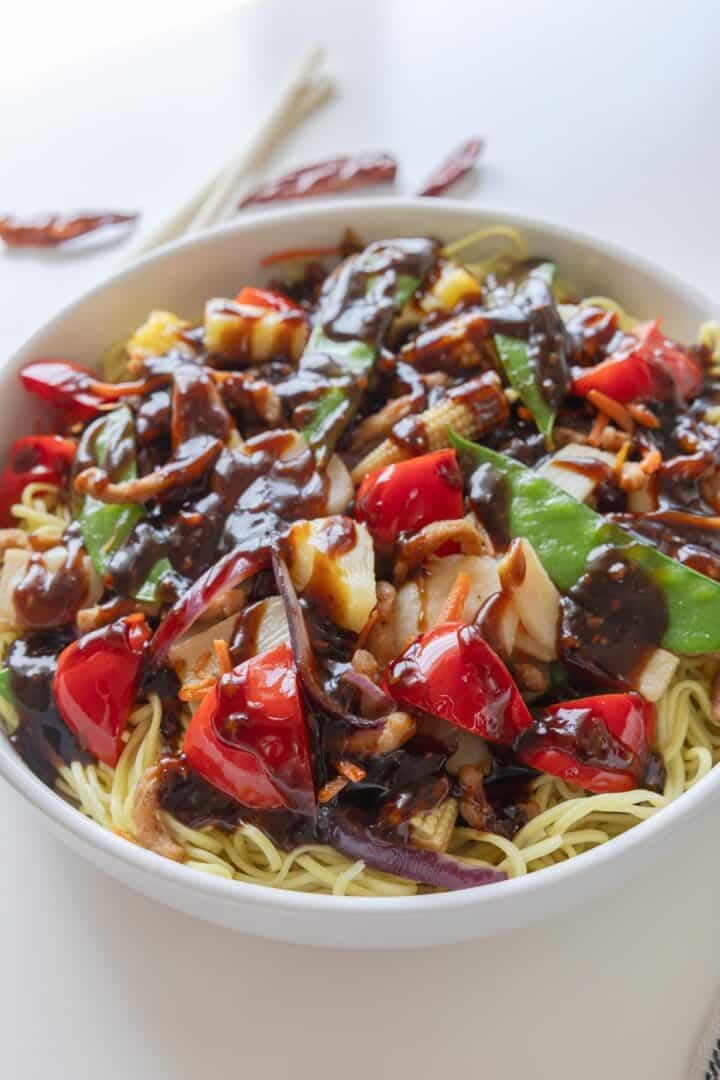
Table of contents
- Continuing My Cardiac Recovery with Delicious, Low Sodium Recipes
- Why Make Your Own Low Sodium Stir Fry Sauce?
- Using TVP from Yang Kee Trading for a Healthy, Protein-Packed Stir Fry
- Ingredients for this Low Sodium Stir Fry Sauce and Meal
- Instructions for Making Low Sodium Stir Fry Sauce and the Meal
- Fun and Creative Ways to Serve Your Low Sodium Stir Fry
- Final Thoughts
Continuing My Cardiac Recovery with Delicious, Low Sodium Recipes
Low sodium vegan recipes have been on the menu as I ease back into creating posts for the blog and working on food photography for clients. I’ve been focusing on meals that are both delicious and heart-healthy. Sodium has been a struggle for me, but through experimentation, I discovered that I could still make a flavorful stir fry sauce without relying on excessive salt. The secret? Pineapple juice!
This homemade low sodium stir fry sauce is light, tangy, and full of umami, making it perfect for those watching their sodium intake. It’s an excellent addition to a colorful vegetable stir fry, and when paired with TVP strips for protein, it makes for a satisfying plant-based meal. If you’re looking for low sodium vegan recipes, this one is a must-try!
Why Make Your Own Low Sodium Stir Fry Sauce?
Most store-bought stir fry sauces are packed with sodium, sometimes exceeding 1,000 mg per serving! That’s way too much if you’re watching your heart health. This homemade version keeps the sodium low by using:
✔️ Low sodium soy sauce instead of regular soy sauce
✔️ Vegetarian oyster sauce or hoisin sauce for richness
✔️ Pineapple juice for natural sweetness and depth
✔️ Rice vinegar for tang
Not only is this sauce low in sodium, but it can also be made oil-free, making it a great choice for whole-food, plant-based (WFPB) eaters.
Using TVP from Yang Kee Trading for a Healthy, Protein-Packed Stir Fry
When looking for a versatile, affordable, and clean plant-based protein, textured vegetable protein (TVP) is an excellent choice. Unlike many store-bought vegan meat substitutes, which are often loaded with oils, preservatives, and additives, TVP is a simple, dried soy product that provides all the protein and texture of meat—without the junk.
What is TVP?
TVP, or textured vegetable protein, is made from defatted soy flour that is processed into various shapes and sizes. Because it is dried, it has a long shelf life, making it a cost-effective pantry staple for anyone following a plant-based diet. When rehydrated, it takes on a meaty texture that works well in everything from stir-fries and curries to tacos and pasta sauces.
Why Choose TVP from Yang Kee Trading?
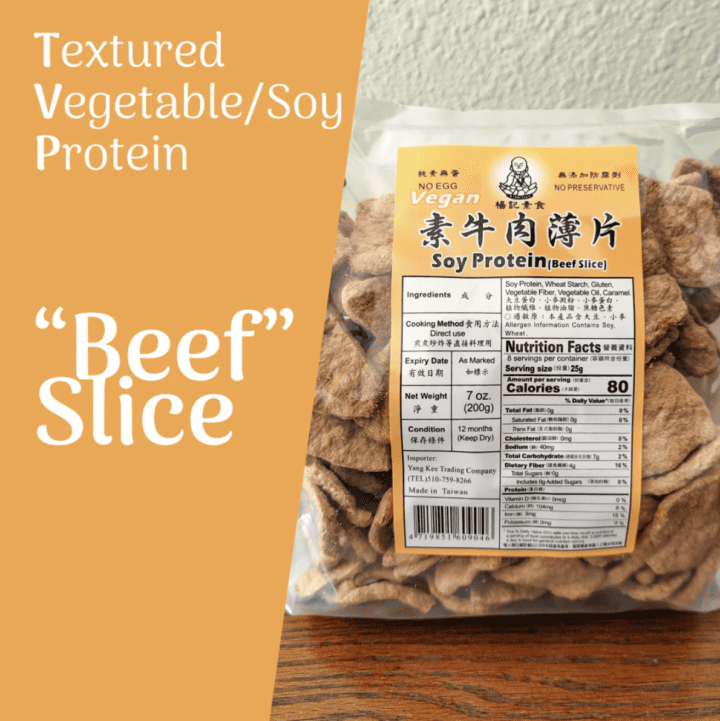
Yang Kee Trading offers a variety of TVP shapes and sizes, allowing for customization depending on the dish you’re making. Whether you want chunky TVP pieces for a hearty stir fry, smaller granules for tacos and chilis, or strips that mimic chicken or beef, they have an option to fit your needs.
✅ Budget-Friendly – A great value for the amount of protein per serving.
✅ Long Shelf Life – Keep it in your pantry for easy meal prep.
✅ Clean & Healthy – No added fats, preservatives, or processed junk.
✅ Versatile – Works in a wide variety of dishes beyond stir fry.
How to Use TVP in a Stir Fry
- Rehydrate: Soak TVP in hot vegetable broth or water for about 10-15 minutes, then drain and squeeze out excess liquid.
- Marinate (Optional): For extra flavor, marinate the rehydrated TVP in low sodium soy sauce, ginger, garlic, and a splash of pineapple juice before cooking.
- Stir-Fry: Cook in a hot pan with your favorite vegetables and the low sodium stir fry sauce for a high-protein, nutrient-packed meal.
By incorporating TVP from Yang Kee Trading into your meal rotation, you can enjoy satisfying, protein-rich vegan meals without relying on overly processed store-bought alternatives. Whether you’re making a stir fry, fried rice, noodle dish, or even a plant-based version of orange chicken, TVP is a smart, wholesome choice for a heart-healthy diet.
Other Recipes You’ll Love:
Ingredients for this Low Sodium Stir Fry Sauce and Meal
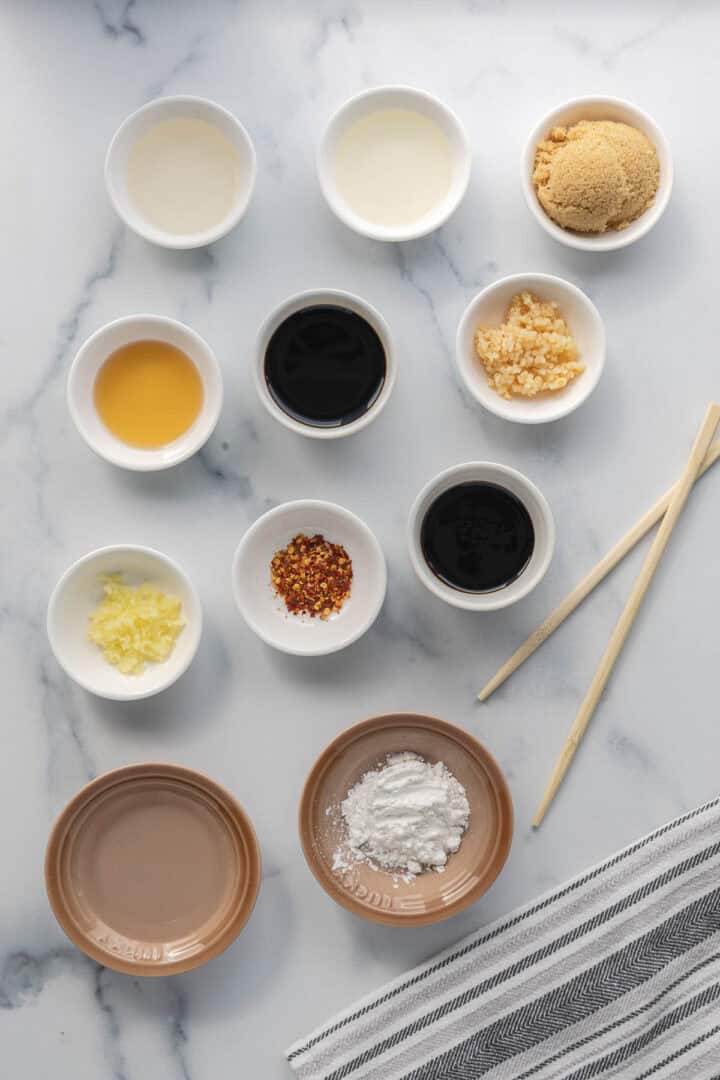
- low sodium soy sauce
- vegetarian oyster sauce (made with mushrooms)
- pineapple juice
- brown sugar
- rice wine vinegar
- cornstarch
- water
- minced garlic
- crushed ginger
- red pepper flake (optional)
- sesame oil (optional)
One of the biggest sources of sodium in traditional stir fry sauces is soy sauce, which can contain up to 1,000mg of sodium per tablespoon. By opting for low sodium soy sauce, you can reduce the sodium content by 40-60% while still getting that rich umami flavor.
- 1 – 2 qt. bottle of Kikkoman Less Sodium Soy Sauce
- Kikkoman users around the world know that this seasoning enhances not only Asian…
- 38% less sodium, with all the same rich, umami flavor
Last update on 2025-07-07 / Affiliate links / Images from Amazon Product Advertising API
Another key component is vegan oyster sauce, which adds a deep, savory taste similar to traditional oyster sauce but with less sodium and no shellfish.
- Create authentic Asian dishes at home with this Wan Ja Shan Vegetarian Oyster…
- NO MSG. VEGAN. NON-GMO. 100% Naturally Brewed. No Chemical Soy Sauce.No Caramel…
- Vegetarian oyster sauce are prepared from mushrooms, mostly oyster mushrooms or…
Last update on 2025-07-07 / Affiliate links / Images from Amazon Product Advertising API
This sauce is so versatile that you can use it with almost any combination of your favorite veggies and protein options. It’s also going to pair well with whatever base you have for a meal, it works equally well with noodles or rice! My trick for getting the sodium count down is to lean on the bold flavor of the pineapple in the recipe. Give it a try and let me know if a sweeter, pinapple forward, sauce helped you tolerate a lower sodium dish.
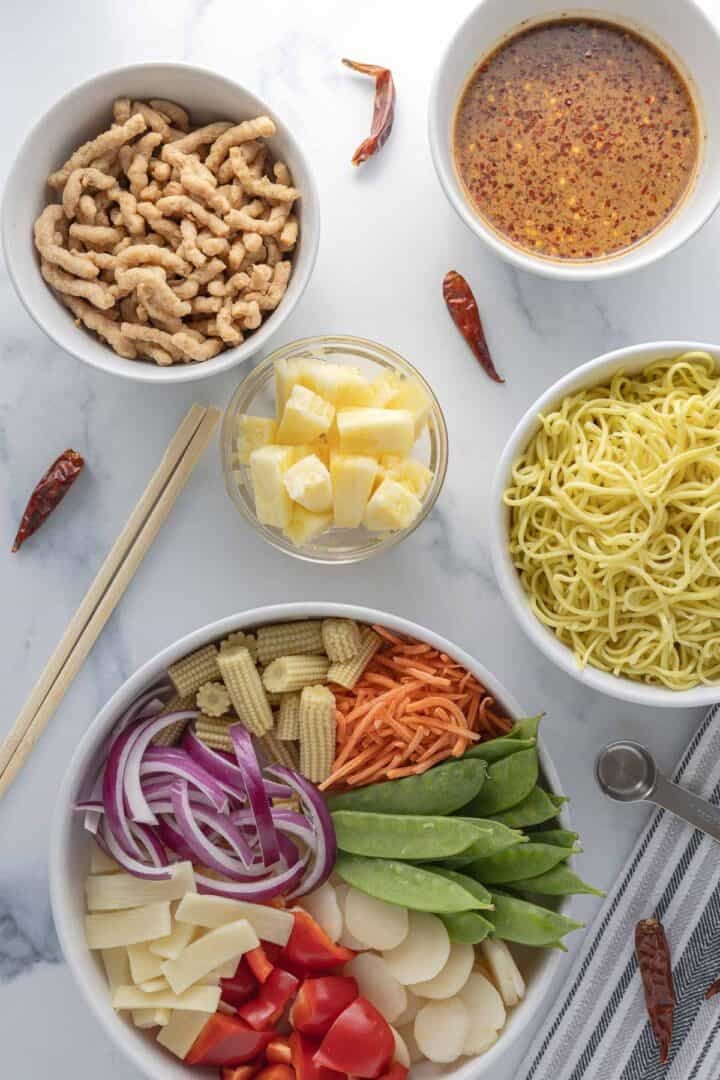
Instructions for Making Low Sodium Stir Fry Sauce and the Meal
For this recipe we’re using the TVP Strips from Yang Kee Trading Company.
- Rehydrate 1 cup of dry TVP with 1 cup of boiling vegetable stock, slices or other shape as you prefer. Alternatively, prepare any other protein choice for use and set aside.
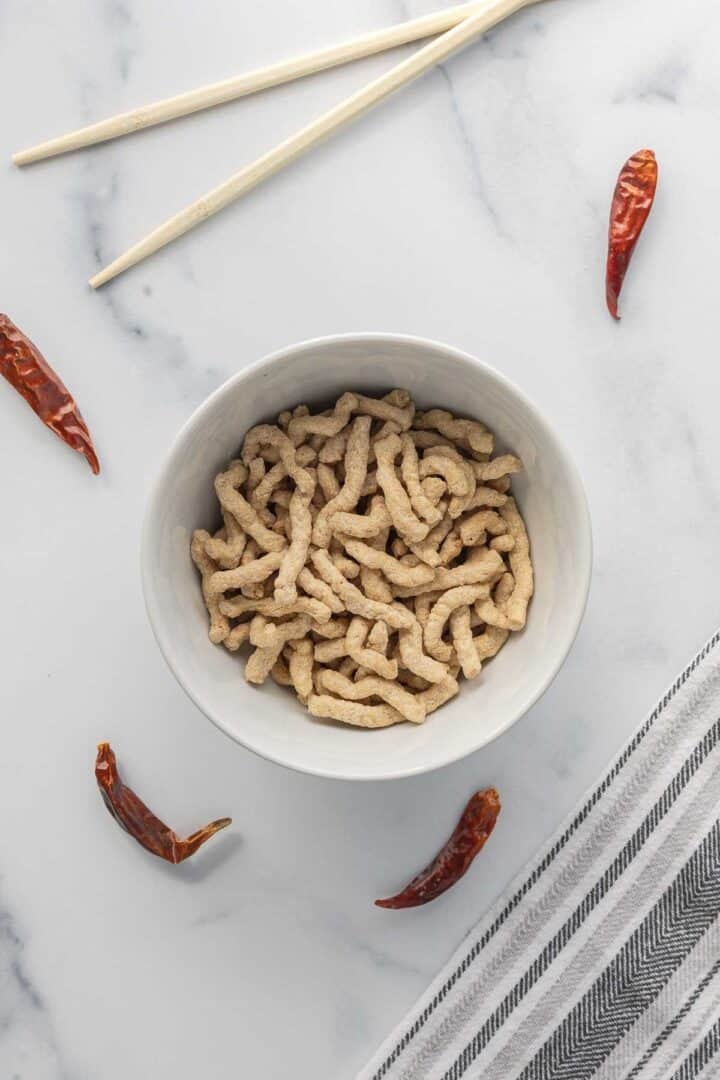
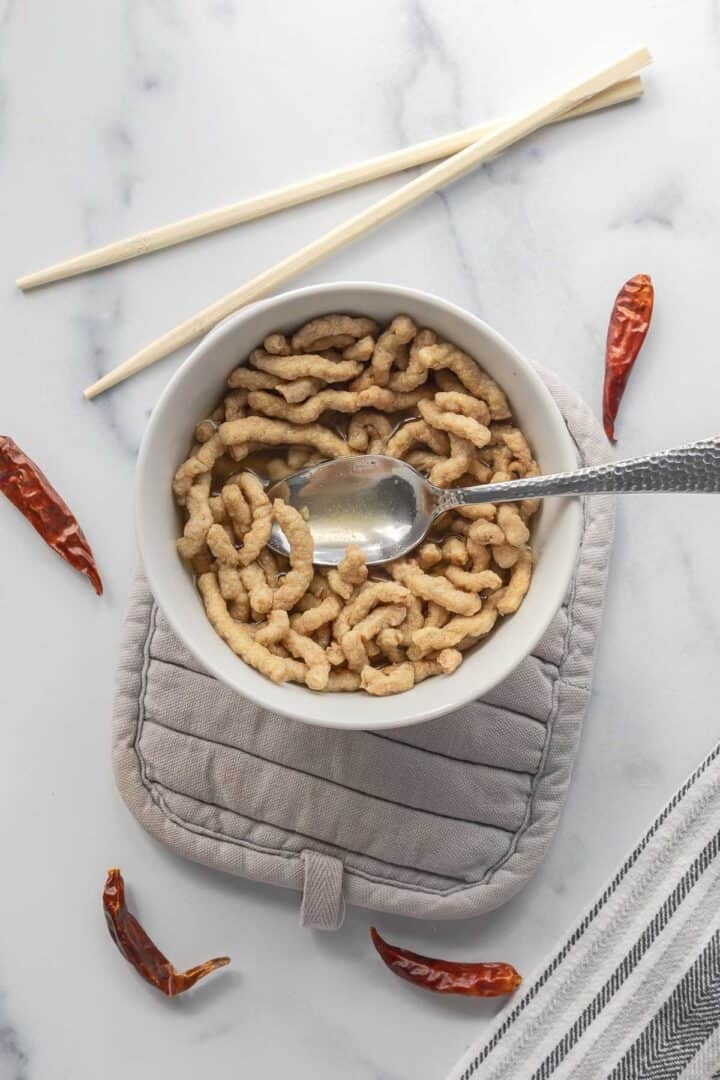

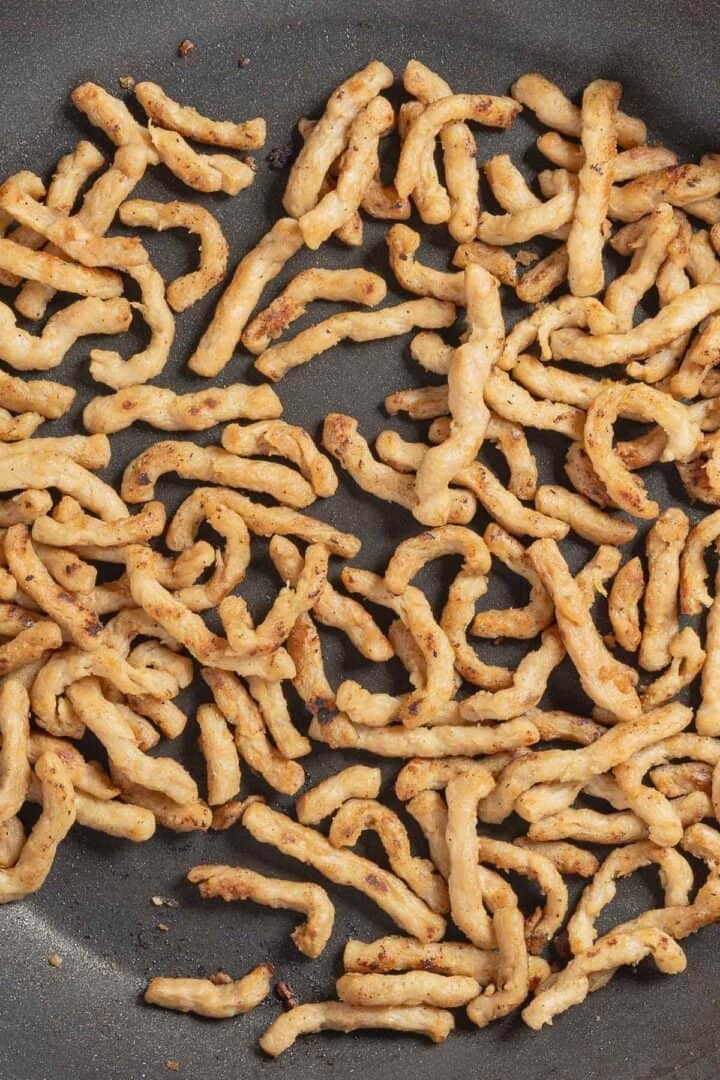
- Let the TVP hydrate for 15 minutes then drain well.
- Heat a non-stick pan or wok over medium heat with a tablespoon of clear neutral oil with a high smoke point, like avocado. Add a splash of water or vegetable broth if cooking oil-free.
- Toss in the TVP pieces and stir-fry for 3-5 minutes until browning begins.
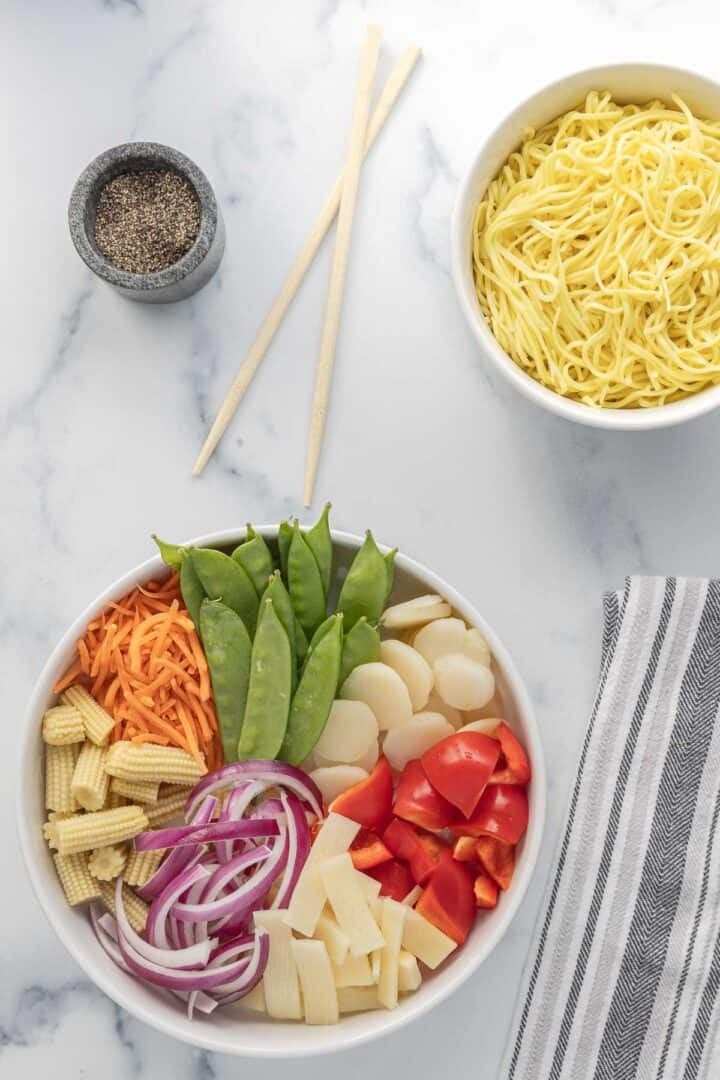
- These noodles were separately boiled per instructions, you can use whichever noodle or rice option you serve the meal with for this step.
- Stir fry the veggies in a non-stick pan or wok over medium to high heat in a tablespoon of sesame oil. Add a splash of water or vegetable broth if cooking oil-free.
- When the veggies just begin to brighten in color, add the protein to the pan along with all of the sauce ingredients minus the corn starch slurry.
- Once the ingredients are well mixed and back up to cooking temperature, mix in the corn starch slurry.
- Cook for one additional minute to thicken up and then remove from the heat to serve.
Fun and Creative Ways to Serve Your Low Sodium Stir Fry
Looking for a way to make your stir fry meal even more exciting? Here are some fun and visually appealing serving ideas to elevate your dish:
🌿 Pineapple Bowl: Serve your stir fry inside a hollowed-out pineapple half for a tropical-inspired presentation. The natural sweetness of the pineapple complements the sauce beautifully!
🍚 Fried Rice Side: Pair your stir fry with low sodium fried rice, made with brown rice, peas, and a touch of toasted sesame oil for extra depth.
🥢 Stir-Fried or Pan-Fried Noodles: Toss your favorite low sodium noodles (such as whole wheat, rice, or shirataki noodles) in a hot pan with a bit of vegetable broth and a drizzle of the stir fry sauce. This makes for a flavorful, saucy noodle dish that pairs perfectly with the stir-fried vegetables and protein.
🍗 Beyond Popcorn Chick’n Plate: Recreate a vegan Panda Express-style meal by serving this sauce over Beyond Meat Popcorn Chick’n or crispy tofu nuggets, along with stir-fried veggies.
By switching up the way you serve your stir fry, you can create a variety of exciting, satisfying meals while keeping things heart-healthy and low in sodium!
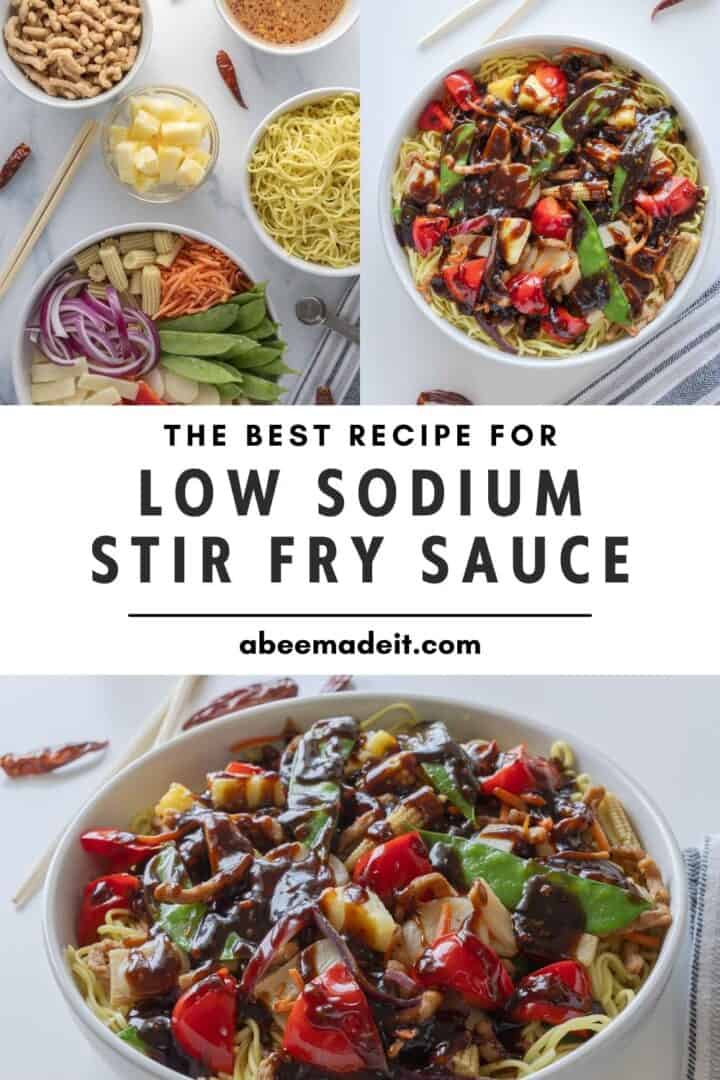
Arrowroot powder or tapioca starch work great as a thickening alternative.
Stored in an airtight container in the fridge, it stays fresh for up to 5 days.
Absolutely! It’s perfect for glazing tofu, marinating veggies, or as a dipping sauce for dumplings.
Simply sauté with vegetable broth or water instead of oil. The sauce adds enough richness!
Yes! Store it in a freezer-safe container for up to 2 months. Just thaw and reheat when needed.
Final Thoughts
This low sodium stir fry sauce proves that you don’t need excessive salt to create a flavorful and satisfying dish. By using pineapple juice and other natural ingredients, we can enjoy a healthy, heart-friendly stir fry that doesn’t compromise on taste.
I’m excited to keep sharing more low sodium vegan recipes as I continue my recovery. If you try this recipe, let me know how it turns out—tag me on social media or drop a comment below!

Get the Recipe Low Sodium Stir Fry Sauce for A Heart Healthy Meal Everyone Will Love!
Ingredients
Ingredients for the Low Sodium Stir Fry Sauce
- 4 tbsp low sodium soy sauce, use 1 tbsp less for a very light sauce
- 2 tbsp vegetarian oyster sauce, or hoisin
- 2 tbsp light brown sugar
- 2 tbsp pineapple juice
- 2 tbsp rice wine vinegar
- 1 tbsp minced garlic
- 1 tsp crushed ginger
- ½ tsp red pepper flake, or white pepper
- 1 tbsp sesame oil, optional
Corn Starch Slurry
- 1 tbsp corn starch
- ¼ cup water
Instructions
Instructions for Making Low Sodium Stir Fry Sauce
- Add all of the sauce ingredients, minus the corn starch slurry, into a non-stick pan or wok over medium heat. If cooking with a meal, add the sauce ingredients when the veggies just begin to brighten in color.
- Once the ingredients are well mixed and up to cooking temperature, mix in the corn starch slurry.
- Cook for one additional minute to thicken up and then remove from the heat to serve.
